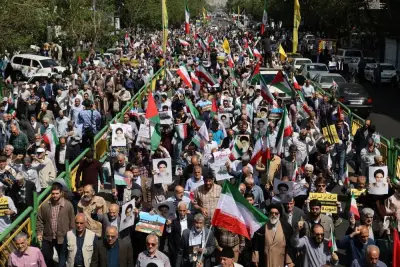A vendor is inspecting Iranian rials at a currency exchange shop in Baghdad (file). The currency, which had hovered around 32,000 per dollar in unregulated markets since April, has lost 8% since November 24.
Bloomberg
Iran’s rial is weakening after months of stability over declining oil prices and uncertainty whether the country will clinch a nuclear deal lifting international sanctions.
The currency, which had hovered around 32,000 per dollar in unregulated markets since April, has lost 8% since November 24, when world powers and Iran extended nuclear talks by seven months after failing to reach a breakthrough.
The rial depreciated to 35,200 per dollar in unregulated trading on Thursday, compared with 32,560 on November 24, according to rates compiled by Daily Rates For Gold Coins and Foreign Currencies, a Facebook page used by traders and companies in Iran and abroad.
“The two factors seem to be the lack of a comprehensive nuclear agreement, therefore the continuation of the financial and energy sanctions, combined with the rather dramatic slide in the oil price, which is a worrying scenario for Iran,” Toby Iles, a senior Middle East analyst at the Economist Intelligence Unit, said in a phone interview from Singapore on Thursday. “Perception definitely plays into this.”
Crude prices have fallen more than 50% from a June peak amid overproduction and slower demand growth. The plunge comes as international sanctions imposed on Iran over its nuclear programme curtail crude exports, the Arabian Gulf nation’s main income source.
Presenting the nation’s budget for the Iranian year starting March 21 to lawmakers, Iranian President Hassan Rouhani said on December 7 that he expected oil prices at five-year lows would place “short-term pressure” on state revenue. The government, which assumed a price of $100 for a barrel in the fiscal year through March, is basing its 2015 spending plan on an average of $72.
Iran will lose about $8bn in oil revenue from June to the end of this Iranian year, the Tasnim news agency reported on December 16.
The government has adjusted the official exchange rate to the dollar in this year’s budget, which “sends a signal to the market,” Kamal Seyed-Ali, a former deputy for foreign exchange affairs at the Central Bank of Iran, said in comments published in the Tehran-based newspaper Shargh. The government can offset some of the lost revenue through that adjustment, he said.
The draft budget being reviewed by parliament is based on an official exchange rate of 28,500 rial to the dollar compared with 26,500 last year, local media including the Iran newspaper have reported.



